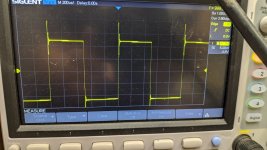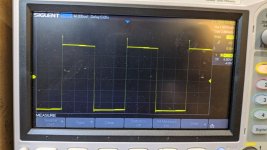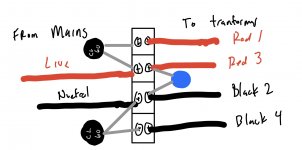Well, this is the noob forum.. 😉
There is another forum for Aleph 30 & Aleph 60. Those are bigger amps with more output devices per channel. What we see there is more applicable to what you would like to do. Also look for Bablefish J by Zen Mod. That amp has options for adding extra output devices. You don't need to double the whole board set, just the output parts to some extent. Those output devices are all that need to be matched.
No output coupling caps are necessary.
Yea, well, im a noob 🤘🙂
No need for added caps, okey, thanks!
My thinking about it is that the sound described about the Aleph J seems to suit my taste. And then the parallel boost might make it even more fun🙂
If it does not work out right in parallel mono, as good as in the ACA parallel setup - i still will have two fine stereo Aleph J:s ready to play anywhere in the Dolby Atmos setup, or bi-amping the stereo setup.
So I figure- anyhow it finally ends up, its Gonna be a very fun journey, building and testing🙂
Last edited:
What I would probably do is this:
Build a dual-mono PSU that could deliver 2.2A at +/– 26V.
Buy a tube of FQH44N10 and sort them into matched pairs.
Get a pair of Aleph J boards and a big a** chassis from the store and go to town.
Build a dual-mono PSU that could deliver 2.2A at +/– 26V.
Buy a tube of FQH44N10 and sort them into matched pairs.
Get a pair of Aleph J boards and a big a** chassis from the store and go to town.
What I would probably do is this:
Build a dual-mono PSU that could deliver 2.2A at +/– 26V.
Buy a tube of FQH44N10 and sort them into matched pairs.
Get a pair of Aleph J boards and a big a** chassis from the store and go to town.
Well, you know what could happen if a noob goes to a big town in a big hot chassis: The Noob, or any of his preciousss components probably would get very SMOKED

But it Sounds like a possible fun project down the road, more power with a some what Aleph J sonic signature? Or is it on top of that something additionaly added sonically with them FQH44N10 mosfets?
The FQH44N10 Mosfets have worked very well in several amps. I used them in my F6, and a few intrepid builders in the "Premium ACA" thread have used them in their amps. They have a very high transconductance, modest input capacitance and low total gate charge. All qualities that lend themselves well to an articulate and dynamic presentation of the music being played. Check out their datasheet compared to the IRFP240. The icing on the cake is that they perform better at somewhat higher Vds and can handle higher power dissipation. So an Aleph J with higher voltage rails is a reasonable proposition.
I am still using the standard IRFP parts in my Aleph J, but I am running it at +/– 25V from a dual CRCRC supply. I did a couple things to help protect the input JFets ('J74). The current source above the input differential pair uses a precision 10V Zener diode at D1 instead of 9.1V. I also installed a 200 Ohm resistor at R30 to drop a little more voltage before the Source pins of the JFets. R30 is also nice to have in order to check the current through the differential pair. I have had my Aleph J on 24/7 with a bias current of 1.8A at times when I was in-between other amp builds. It does take some time to fully warm up and sounds better once it does.
We are gradually moving out of noob territory here, and into Intrepid Amp Builder territory. Not quite in Fearless Amp Builder territory yet, so no need to don the Nomex fireproof suit when powering up the amp for the first time. Certainly is time to understand how to calculate currents and power dissipation though.
I am still using the standard IRFP parts in my Aleph J, but I am running it at +/– 25V from a dual CRCRC supply. I did a couple things to help protect the input JFets ('J74). The current source above the input differential pair uses a precision 10V Zener diode at D1 instead of 9.1V. I also installed a 200 Ohm resistor at R30 to drop a little more voltage before the Source pins of the JFets. R30 is also nice to have in order to check the current through the differential pair. I have had my Aleph J on 24/7 with a bias current of 1.8A at times when I was in-between other amp builds. It does take some time to fully warm up and sounds better once it does.
We are gradually moving out of noob territory here, and into Intrepid Amp Builder territory. Not quite in Fearless Amp Builder territory yet, so no need to don the Nomex fireproof suit when powering up the amp for the first time. Certainly is time to understand how to calculate currents and power dissipation though.
Are you sure of it ,,, cuz i had fluke dmm at a time and don't have a good experience with them ,,,if you want to keep this hobby going for years to come, Fluke DMM is the best choice.
If DIY Alpha J is just one time deal, then get whatever the cheapest is.
have you tried others or you have only used them saying this
Whenever I see anybody on YouTube who has built or fixed hundreds of amps, they all seem to have Fluke. Not sure why. I couldn’t afford one so I got a Klein, which seems to be working fine. But just as mechanics go for Snap-on and and techs go for Tektronix scopes, the experienced guys have Fluke. If I ever become an experienced guy, I’ll probably have a Fluke too. I can tell you I splurged for a Hakko soldering iron, and I’m glad I did.
Given the choice of a Fluke or a Hakko, I'd take the Hakko too.
I have a Hakko and no Fluke. Plenty of "other" multimeters though, and they work for me.
I have a Hakko and no Fluke. Plenty of "other" multimeters though, and they work for me.
So, thanks to a recent find on the swap meet, I am planning an Aleph J build in the near future.
I have a nice 2x20V 625VA transformer - has anyone used 2 x power boards in parallel, one for each channel from a single transformer? Meaning CRC using 6 x 22kuF per channel after discrete diodes on each board? Overkill? Worth the experiment?
I have a nice 2x20V 625VA transformer - has anyone used 2 x power boards in parallel, one for each channel from a single transformer? Meaning CRC using 6 x 22kuF per channel after discrete diodes on each board? Overkill? Worth the experiment?
Well, some progress has been made, and I'm happy to say that the Aleph J is up and running. I had to increase the heatsinking on the msr860 diodes a bit, they were getting a bit toasty for my liking with the original heatsinks, but with the larger plates they are staying at a reasonable temperature. All voltages measure just fine which is just great. The amp is built on Peter Daniels boards, matched 240s, J109 fet, 24v rails (loaded) with 66kuF per rail (ie 132kuF in total).
I have one question - when I put a square wave through the amp, I get some ringing - in this amp C5 is currently unpopulated, and I think I remember reading that C5 has an influence on the ringing behaviour. Can anyone give direction on this - no matter how I searched I couldn't find where I picked that up. Also 5pF is truly tiny. Would a couple of twists of wire do the job? I don't think I can even measure that low down.

I have one question - when I put a square wave through the amp, I get some ringing - in this amp C5 is currently unpopulated, and I think I remember reading that C5 has an influence on the ringing behaviour. Can anyone give direction on this - no matter how I searched I couldn't find where I picked that up. Also 5pF is truly tiny. Would a couple of twists of wire do the job? I don't think I can even measure that low down.

I managed to find a 5pF ceramic disc - hardly befitting a mighty Aleph.
Anyway, it drastically improves the ringing. I also found a 22pF in the parts stash but it was too much - the front end of the wave was rounded off. I'll order up some of the recommended silver mica whenever I am ordering anything from the supply houses again. Maybe I'll order 5 and 7.5pF and see which is best.
@Zen Mod - thanks for the reply - that is two builds you have helped me out with in the past months.

Anyway, it drastically improves the ringing. I also found a 22pF in the parts stash but it was too much - the front end of the wave was rounded off. I'll order up some of the recommended silver mica whenever I am ordering anything from the supply houses again. Maybe I'll order 5 and 7.5pF and see which is best.
@Zen Mod - thanks for the reply - that is two builds you have helped me out with in the past months.

Small update:
As per the post above I put in a crappy 5pF ceramic disc cap - the only thing I had that low down. It tamed a lot of the ringing as per the scope shot above. In my next order I added some 5pF and 7pF silver mica. I tried both this evening and 7pF seems to be the sweet spot - the tiny bit of ringing in the scope shot above is gone, but with minimal rolling off at the corner of the square wave.
However, the real surprise here is the change in sound quality. It really has made a much larger difference than I could have imagined. Whether its the 7pF and a cleaner square wave, or using silver mica instead of bottom of the pile ceramic disc (the really low end orange disc ones) I won't ever know.
In short, its worth picking up a couple of values of these caps and looking for the best square wave shape if you have a scope and generator.
As per the post above I put in a crappy 5pF ceramic disc cap - the only thing I had that low down. It tamed a lot of the ringing as per the scope shot above. In my next order I added some 5pF and 7pF silver mica. I tried both this evening and 7pF seems to be the sweet spot - the tiny bit of ringing in the scope shot above is gone, but with minimal rolling off at the corner of the square wave.
However, the real surprise here is the change in sound quality. It really has made a much larger difference than I could have imagined. Whether its the 7pF and a cleaner square wave, or using silver mica instead of bottom of the pile ceramic disc (the really low end orange disc ones) I won't ever know.
In short, its worth picking up a couple of values of these caps and looking for the best square wave shape if you have a scope and generator.
You could try 2 polystyrene 10pF caps in series. Or, do what Nelson suggested: make a 20cm long twisted pair and then keep trimming until you get a nice looking oscilloscope square wave. This should provide the best sound, but the twisted pair capacitor will need to be heat shrinked, to prevent loss of capacitance....
I'd place silvered mica and disk ceramic caps in the same basket sound quality-wise. Polystyrenes sound much better, but they don't come in 5pF flavour anymore...
I'd place silvered mica and disk ceramic caps in the same basket sound quality-wise. Polystyrenes sound much better, but they don't come in 5pF flavour anymore...
Ok I might keep an eye out for some low value polystyrenes. I did go looking recently in some of the scrap boards I have knocking around, but the polystyrenes were all much higher values in the 50pf range and there were only a few anyway.
So as I said, I don't know if the improvement is due to silver mica or getting the right value for a really clean square wave but it's one of those two things I think.
So as I said, I don't know if the improvement is due to silver mica or getting the right value for a really clean square wave but it's one of those two things I think.
Hi,
Do any of you guys have an illustration (or actual picture) of the wiring diagram from the IEC inlet towards the terminal block where the primaries are wired to (the one with the inrush limiters and safety capacitors) for 240V?
Yes there's is a detailed schematic provided in the Aleph J build, but unfortunately, a newbie like me can't really read or understand the schematics well enough to make sure that I understand it correctly.
Sample illustration below (also posted in one of the pages here), but this is 120V. What I need is for 240V wiring.
Do any of you guys have an illustration (or actual picture) of the wiring diagram from the IEC inlet towards the terminal block where the primaries are wired to (the one with the inrush limiters and safety capacitors) for 240V?
Yes there's is a detailed schematic provided in the Aleph J build, but unfortunately, a newbie like me can't really read or understand the schematics well enough to make sure that I understand it correctly.
Sample illustration below (also posted in one of the pages here), but this is 120V. What I need is for 240V wiring.
Attachments
Please post exact manufacturer and part number for your power transformer. A picture is also useful. A link to the specifications of the transformer would be most useful.
Hi,Please post exact manufacturer and part number for your power transformer. A picture is also useful. A link to the specifications of the transformer would be most useful.
Jim was kindly to already assist me on this regard. Hopefully, once I get to finish my project, I will post pictures here for our community that uses 240V mains. Thanks!
- Home
- Amplifiers
- Pass Labs
- Aleph J build guide for noobs

